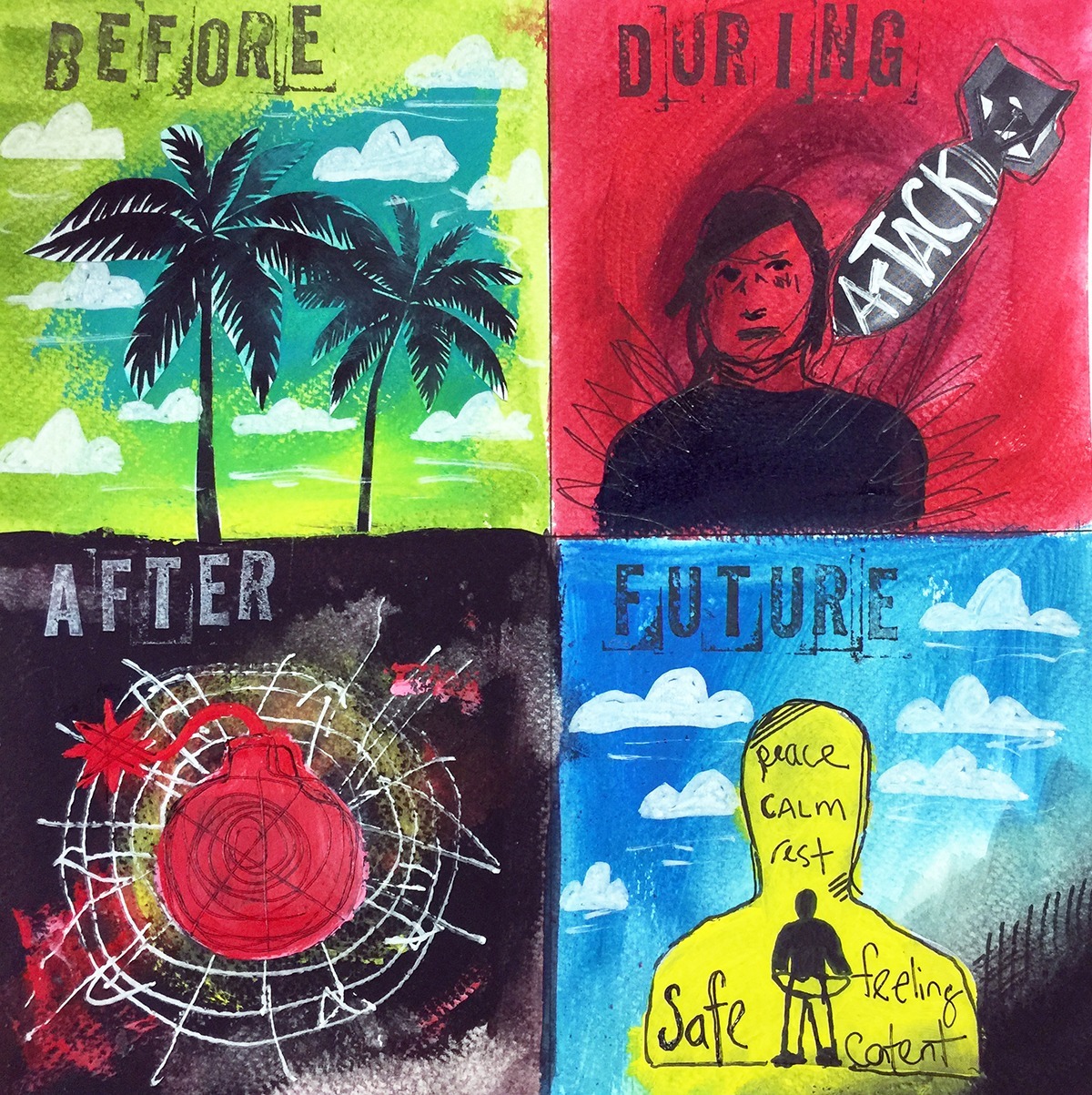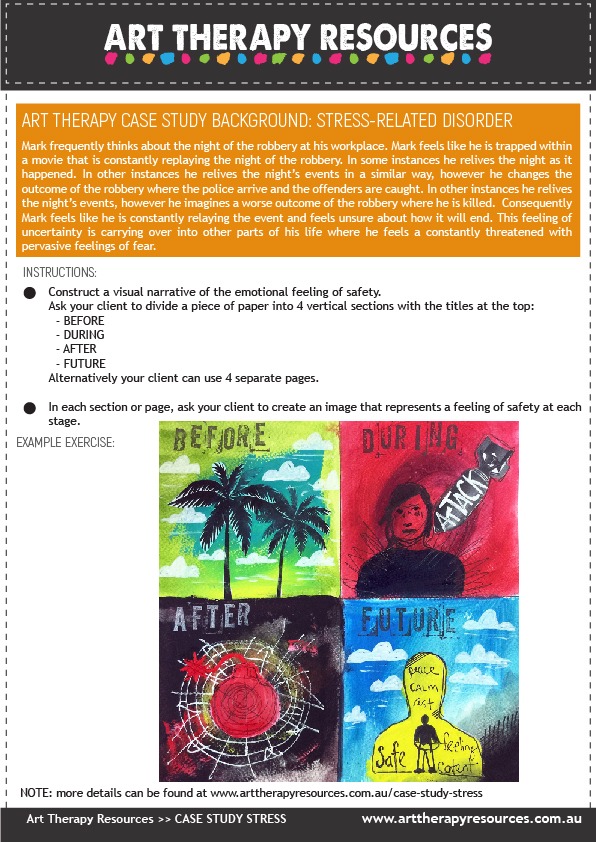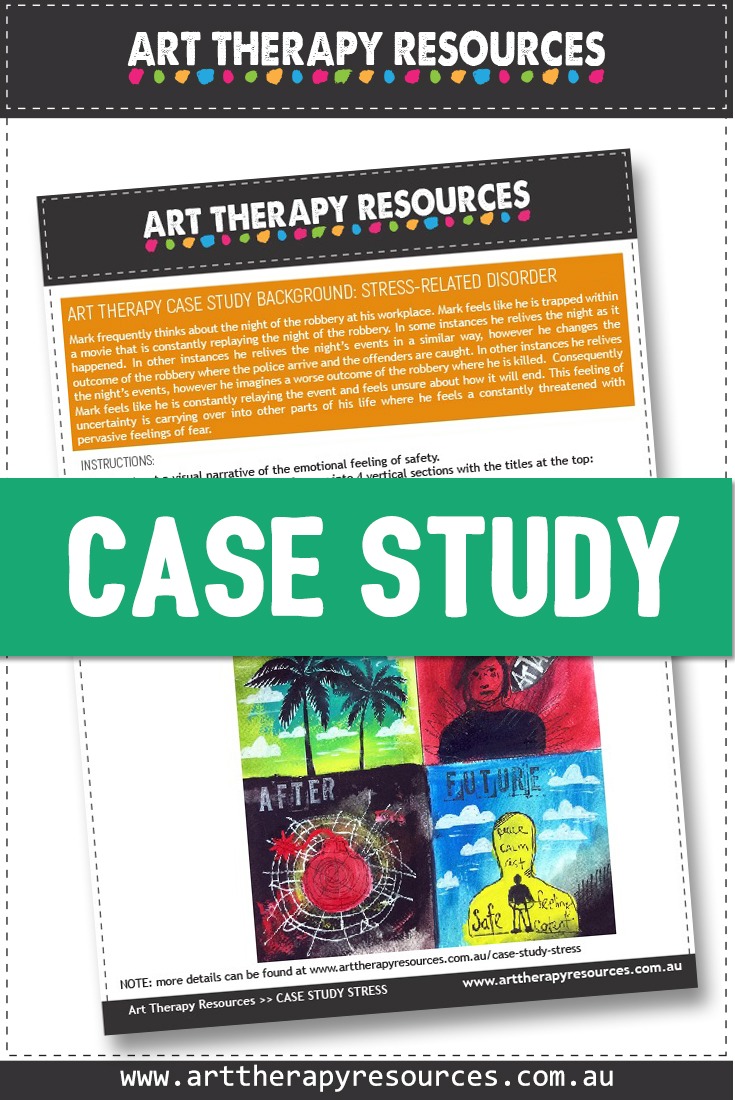THIS POST INCLUDES:
- Art Therapy and Stress-related Disorders
- About the Client
- Current Client Issues
- Art Therapy Exercise
- Client Insight and Outcomes
- Disclaimer
- FREE DOWNLOAD Art Therapy Exercise
ART THERAPY AND STRESS
The word stress has become a common word to explain the level of anxiety we experience in a given situation. Typically, as the event subsides, so do our heightened emotions, and within a short time we are able to return to normal daily functioning.
The experience of trauma and stress as defined in the DSM-5, relates to more extreme traumatic stressors such as witnessing a death, or a physical threat to self or others. Often in traumatic events, severe anxiety will develop along with other symptoms of dissociation. An individual experiencing this kind of acute stress often has difficulty concentrating, experiences recurring images, thoughts, and dreams, and can relive the distress when exposed to reminders of the traumatic event.
As with most psychological processes, individual experiences to the same event may vary between two people in both duration and intensity of the symptoms. Many factors contribute to the emotional experience of a traumatic event including the nature of the event, previous life experiences, personality, coping skills and available support following the event.
Individuals who suffer from acute stress and trauma can experience many of the below physical symptoms:
- Headaches
- Insomnia and general sleep disturbances (dreams etc)
- Indigestion problems
- Anxiety
- Anger
- Depression
- Fatigue
- Mood instability
- Difficulty concentrating
- Weak immune system
- High blood pressure
Experiencing these physical symptoms over a long period of time can be extremely harmful to an individual’s daily functioning and overall health. Therefore it is important to address the underlying issues behind the trauma. In addition to these physical symptoms, individuals can also experience cognitive, behavioural and emotional dysfunction as a result of the trauma.
Art Therapy can be useful for individuals who have experienced a traumatic event and are suffering from ongoing acute stress. Activities can facilitate memory reconstruction as well as aid in self-regulating sensory experiences. Art Therapy also provides a relief from verbal communication demands, and allows the individual to explore self-expression through visual communication.
Stress-related disorder is a general term, however the DSM-5 details various subtypes:
TRAUMA & STRESS-RELATED DISORDERS (subtypes)
- Reactive Attachment Disorder
- Disinhibited Social Engagement Disorder
- Posttraumatic Stress Disorder (PTSD)
- Acute Stress Disorder
- Other Specified Trauma/Stress-Related Disorder
- Unspecified Trauma/Stress-Related Disorder
HELPFUL CONTACTS:
- Beyond Blue
- Sane Australia
- Phoenix Australia
- PTSD Alliance
- International Society for Traumatic Stress Studies
The most common experiences with stress-related disorders is acute stress disorder and Posttraumatic Stress Disorder (PTSD)
ACUTE STRESS DISORDER:
Acute stress disorder is the most common form of stress. The most common symptoms are:
- Emotional distress – the main 3 stress emotions of anger, anxiety and depression
- Physical symptoms – headaches, back pain, jaw pain, stomach problems, high blood pressure, rapid heartbeat, sweaty palms, dizziness, shortness of breath.
Acute stress is treatable and manageable within a shorter time frame. Typically the symptoms don’t last longer than a month.
Regular acute stress can be classified as episodic acute stress which is explained by a regular series of highly stressful events. Some of these events can be external or a reflection of the client’s perception. The classic “Type A” personality by experience episodic acute stress.
Chronic stress is the ongoing grinding stress that is experienced usually over a lifetime. A person experiencing chronic stress may have lived in a dysfunctional family, been raised in poverty, entered in an unhappy marriage, have a highly stressful or unhappy job.
The unrelenting pressure of the events over the individual’s lifetime usually results in overall poor health as well as an inability to recognise the effects of stressful events due to the familiarity over a lifetime.
PTSD (posttraumatic stress disorder):
PTSD occurs after a stressful event that is threatening in nature. The feelings of distress are pervasive and extend beyond the typical 4 week period that occurs with acute distress. For that reason, a diagnosis of PTSD is typically not given until after a month.
Typical stress events include natural disasters, war, serious accidents, situations involving violence and abuse or witnessing these violent situations.
Typical symptoms of PTSD include:
- Flashbacks
- Emotional distress
- Emotional numbness
- Detachment from everyday life
- Hyper arousal and hyper vigilance
PTSD is treatable and success has been documented around the benefits of art therapy with combat veterans.
Research has found that art therapy can improve the way in which individuals process the trauma through recall and accessing emotions.
You can read an excellent case study of using art therapy with an active duty military service member with symptoms of chronic PTSD and mild TBI (traumatic brain injury).
Art therapy for PTSD and TBI: A senior active duty military service member’s therapeutic journey
ABOUT THE CLIENT
- Name: Mark
- Gender: Male
- Age: 48
- Summary of sessions to date: Mark had experienced a hold up at his workplace 2 weeks ago. Another therapist had referred him for Art Therapy to help him deal with pervasive thoughts connected to the robbery. The other therapist knew that Mark was interested in art.
CURRENT CLIENT ISSUES
Mark frequently thinks about the night of the robbery at his workplace. Mark feels like he is trapped in a movie that is constantly replaying the night of the robbery. In some instances, he relives the night as it happened. In other instances he relives the night’s events in a similar way, however, he changes the outcome of the robbery where the police arrive and the offenders are caught. In other instances he relives the night’s events, however, he imagines a worse outcome of the robbery where he is killed.
Consequently, Mark feels like he is constantly relaying the event and feels unsure about how it will end. This feeling of uncertainty is carrying over into other parts of his life where he feels a constantly threatened with pervasive feelings of fear.
ART THERAPY EXERCISE
INSTRUCTIONS:
Construct a visual narrative of the emotional feeling of safety.
Ask your client to divide a piece of paper into 4 vertical sections with the titles at the top:
- BEFORE
- DURING
- AFTER
- FUTURE
Alternatively your client can create each section on 4 separate pages.
In each section or page, ask your client to create an image that represents a feeling of safety at each stage.
CLIENT INSIGHT AND OUTCOMES
After completing the art therapy exercise, Mark was able to understand that this trauma represented a moment in time. He could see that life at various stages can be safe for him and that the incident is impacting him at this time.
Mark’s use of the ticking time bomb was a reflection of how he felt at this time. He felt he was emotionally unstable and could “go off” at any time. Upon reflection, the bomb analogy provided insight into how he could learn to implement techniques that might defuse the emotional feelings he had.
Mark felt hopeful that he could move into another era of feeling safe. Mark felt the exercise gave him some clarity on how he was stuck in a moment of time and that if he felt safe before the event, there was hope he could feel safe again.

DISCLAIMER
This case study represents a snapshot of the client’s progress in treatment. The exercise in this article could be used as written or as a guide for new and original tasks developed by the Art Therapist. Responsibility for treatment resides with the individual therapist who understands their clients specific needs. The art therapy exercise should not be viewed as a pre-defined directive on how to treat a client that presents with a specific range of problems.This art therapy exercise will help build a database of knowledge to draw upon when helping your client. Art Therapy is associated with psychotherapy techniques, however each therapist often approaches therapy with their own foundation of psychological interventions, whether it be psychotherapy, CBT, DBT or other methods.
FREE DOWNLOAD: Art Therapy Exercise
Download the FREE Art Therapy Exercise based on the above Case Study. The free download includes instructions for the art therapy exercise, along with an example of the art therapy exercise.

BUILD YOUR ART THERAPY REFERENCE MATERIALS:
Pin this image to your Pinterest board.

SHARE KNOWLEDGE & PASS IT ON:
If you’ve enjoyed this post, please share it on Facebook, Twitter, Pinterest. Thank you!
